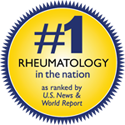Background:
A handful of genes which confer susceptibility to the development of RA are known, such as the HLA-DR “shared epitope” and variants in the PTPN22 gene. While these genes convey a relatively large degree of risk, identifying important genetic loci that convey more modest levels of risk have been a challenge due to the limitations of genetic research methods. Newer methods, such as the use of genome-wide association studies involving hundreds of thousands of single nucleotide polymorphism (SNP) markers, can aid in the discrimination of genes with modest, yet potentially important and informative, effects on risk. Here, Plenge et al (NEJM 2007; 357:977) report the results of a genome-wide association study of 1,522 anti-CCP antibody positive RA patients.
Methods:
Subjects derived from a number of sources. The first, comprising 908 anti-CCP positive RA patients of self-reported European ancestry, was drawn from the North American Rheumatoid Arthritis Consortium (NARAC) family collection, the National Data Bank for Rheumatic Diseases, The National Inception Cohort of Rheumatoid Arthritis Patients, and the Study of New Onset Rheumatoid Arthritis (SONORA). Controls for this population (n=1260) were taken from the subjects in the New York Cancer Project who also self-reported European ancestry. A second cohort, drawn from the Swedish Epidemiological Investigation of Rheumatoid Arthritis (EIRA), was made up of 676 anti-CCP positive patients and included 673 demographically and geographically matched non-RA controls.
Each group was randomly divided into two groups, the first used for the initial genome-wide association scan and the second for a replication scan. The North American population sample had 545,080 single nucleotide polymorphisms (SNPs) genotyped using a variety of platforms. The Swedish population had 317,503 SNPs genotyped using the HumanHap300 platform. Of the candidate SNPs, 297,086 met filter criteria based on call rate, allele frequency, and population genetics.
Replication scanning of 9 tagging SNPs in the candidate region identified from the initial genome-wide scan was conducted using the Sequenom iPLEX platform.
Results
297,086 SNPs passed quality control filters and were used for genome-wide analysis. Three SNPs met the pre-determined level of statistical significance for anti-CCP RA (p-value < 5×10-8), a SNP in the region of the TRAF1-C5 gene on chromosome 9, and two previously known (PTPN22 on chromosome 1 and MHC (site of the “shared epitope”) on chromosome 6). The allelic odds ratio for the TRAF1-C5 SNP was 1.36 (95% CI 1.23 – 1.50).
This same SNP was identified as a major risk locus in the replication scan using tagging SNPs in the TRAF1-C5 region and was significantly associated with risk of anti-CCP positive RA in the combined population (p-value=2.8×10-8). However, the magnitude of association was not uniform across populations, as the odds ratio in the Swedish replication sample was only 1.11 (95% CI 0.93 – 1.32) compared to 1.37 (95% CI 1.18 – 1.58) in the North American population. However, combining the population resulted in an odds ratio of 1.32 (95%CI 1.23 – 1.42) associated with the presence of any copy of the at-risk allele. Subjects homozygous for the risk allele had a higher odds ratio (1.87 (95% CI 1.61-2.18)) vs. those without any risk alleles. The attributable risk of anti-CCP positive RA associated with the allele was 7%.
Fine-mapping in the TRAF-C5 region could not distinguish whether the SNP in question was functionally causal, or whether a closely linked locus was the true causative variant.
Conclusion
A variant in the TRAF1-C5 gene region was associated with a small, but significant increase in the risk of anti-CCP positive RA in person of European ancestry, conferring an attributable risk of approximately 7%.
Editorial Comment
RA is a complex, polygenic disorder and, much like other diseases of this sort (diabetes, atherosclerotic heart disease) have many genetic determinants that each may make small but significant contributions to risk. The findings here are compelling, and automatically command subsequent research into the mechanistic basis of how variants in the genes encoded in TRAF1-C5 region may lead to an increased risk for RA.
Assembling the number of subjects required for a study of this kind is impressive, though some criticisms may arise from the source populations used. In particular, the confounding effect of population stratification in genetic association studies can lead to spurious findings when the source populations are not homogeneous. Here, only participants of self-reported European ancestry were included. However, this strategy may not provide a sample with sufficient homogeneity to avoid issues with confounding by population stratification given differences in genetic background between northern and southern Europeans. Indeed, the allelic association of the identified SNP in TRAF1-C5 was not as robustly associated with RA in the population with the most homogenous sample (those originating from Sweden), suggesting that some residual confounding from population stratification may be present.
In order to avoid these confounding issues in genetic association studies, assembling a restrictive sample is often required, limiting the generalizability of study findings. Indeed, the results presented here are essentially valid only for anti-CCP positive RA in those of European heritage. Despite these limitations, this study and others from these investigators are among the most rigorous of any genetic work performed in RA, and are likely to provide many insights into the pathogenesis that may lead to improved therapy, earlier identification of at-risk patients, and potentially cures.

